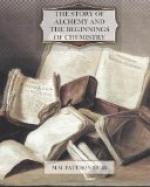Although each class of substances was said by the alchemists to have its own particular character, or life, nevertheless they taught that there is a deep-seated likeness between all things, inasmuch as the power of the essence, or the one thing, is so great that under its influence different things are produced from the same origin, and different things are caused to pass into and become the same thing. In The New Chemical Light it is said: “While the seed of all things is one, it is made to generate a great variety of things.”
It is not easy now—it could not have been easy at any time—to give clear and exact meanings to the doctrines of the alchemists, or the directions they gave for performing the operations necessary for the production of the object of their search. And the difficulty is much increased when we are told that “The Sage jealously conceals [his knowledge] from the sinner and the scornful, lest the mysteries of heaven should be laid bare to the vulgar gaze.” We almost despair when an alchemical writer assures us that the Sages “Set pen to paper for the express purpose of concealing their meaning. The sense of a whole passage is often hopelessly obscured by the addition or omission of one little word, for instance the addition of the word not in the wrong place.” Another writer says: “The Sages are in the habit of using words which may convey either a true or a false impression; the former to their own disciples and children, the latter to the ignorant, the foolish, and the unworthy.” Sometimes, after descriptions of processes couched in strange and mystical language, the writer will add, “If you cannot perceive what you ought to understand herein, you should not devote yourself to the study of philosophy.” Philalethes, in his Brief Guide to the Celestial Ruby, seems to feel some pity for his readers; after describing what he calls “the generic homogeneous water of gold,” he says: “If you wish for a more particular description of our water, I am impelled by motives of charity to tell you that it is living, flexible, clear, nitid, white as snow, hot, humid, airy, vaporous, and digestive.”
Alchemy began by asserting that nature must be simple; it assumed that a knowledge of the plan and method of natural occurrences is to be obtained by thinking; and it used analogy as the guide in applying this knowledge of nature’s design to particular events, especially the analogy, assumed by alchemy to exist, between material phenomena and human emotions.




